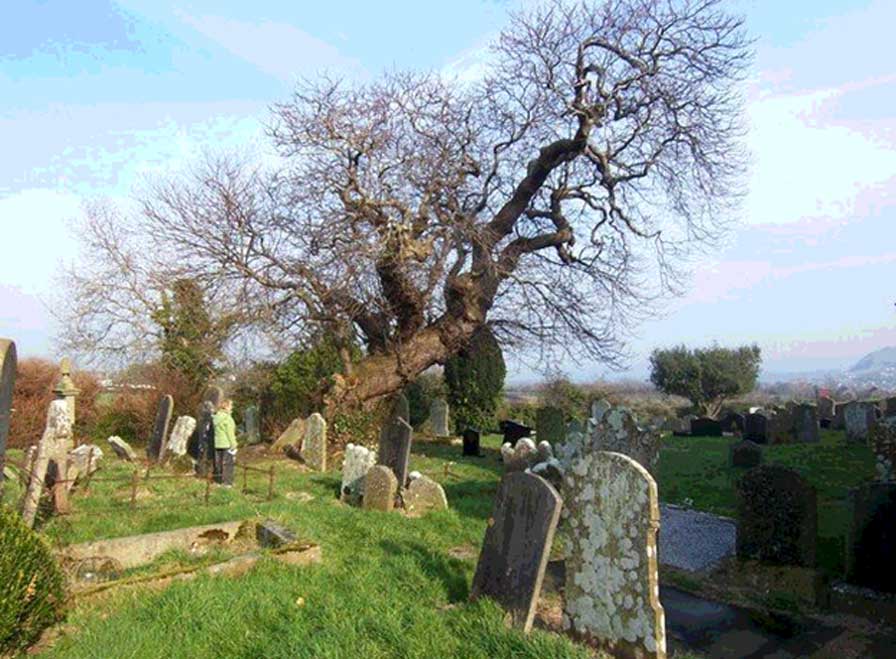The Armada Tree: Sprouted from a Seed in the Pocket of a Fallen Invader
The Armada Tree is the name given to a sweet chestnut tree in the graveyard of a small church in Northern Ireland, UK. According to local legend, the tree grew, rather unintentionally, from a chestnut seed ‘brought’ there by a Spaniard who was part of the Spanish Armada. A modern scientific analysis of this extraordinary tree has lent some truth to the popular local tale.
The Spanish Armada Sets of to Invade England
The Spanish Armada was a fleet consisting of about 130 ships carrying roughly 8000 sailors, and possibly as many as 19000 soldiers. The goal of this fleet was to invade England, in conjunction with a Spanish army from Flanders.

English ships and the Spanish Armada, August 1588. (Public Domain)
The English were a thorn in the side of the Spanish for two main reasons, the first being of a religious nature and the second related to trade. Firstly, the English Reformation had been launched earlier in the same century, resulting in England’s break with Rome and turning it into a Protestant state. Philip II, the King of Spain, hoped that by conquering England, the country could be converted back to Roman Catholicism. Additionally, the English were supporting the Dutch rebels, who were also Protestants, against Spain.
- A Tradition Revived? Inverted Christmas Trees May Have Pagan Roots
- Fancy Sipping a Pint in a 1700-Year-Old Tree? You Can at The Baobab Tree Bar
- Oldest Examples of ‘Tree of Life’ Designs Discovered in Domuztepe Mound, Turkey

Philip II, the King of Spain (Public Domain), hoped that by conquering England, the country could be converted back to Roman Catholicism.
Secondly, English privateers, such as Sir Francis Drake, were raiding Spanish possessions in the Caribbean, causing much damage to their commerce. These factors convinced the Spanish king that an invasion of England was necessary.
Preparations for the armada took about two years, and it was finally launched by Philip II in 1588. In May of that year, the Spanish Armada, under the command of Alonso Pérez de Guzmán, the Duke of Medina-Sidonia, set sail for England from Lisbon.
Result of the Attack
The Armada finally reached the Strait of Dover on August 6th, 1588 and anchored off Calais. At midnight of the following day, the English launched eight fire ships into the Spanish fleet. In order to avoid catching fire, the Spanish were forced out to sea - breaking their formation. At dawn of the following day, the English attacked the scattered Spanish ships, and the Spanish were beaten at the Battle of Gravelines.

Launch of English fireships against the Spanish Armada, 7 August 1588. (Public Domain)
Still, the Spanish Armada was not completely destroyed, and it was thanks to the winds that the Spanish failed to invade England. The winds blew the Spanish ships northwards, and they were only able to return home by circumnavigating the British Isles. Some of the ships were blown into the open sea, whilst others were wrecked on the west coast of Ireland. When the armada finally returned to Spain, only 60 ships remained, many of which were damaged beyond repair. Additionally, it has been estimated that about 15,000 men perished during this undertaking.
- Woe of the Witches – The Elevated Flying Rowan Tree
- Not the Biggest, Not the Tallest, Not the Widest - So What Makes this Giant Sequoia The ‘President’?
- A Symbol of Peace, Victory, and Abundance: The Millennia-Old History of the Olive Tree
The Strange Growth of the Armada Tree
It is believed that the Armada Tree came into being thanks to one of these Spaniards who perished on the armada’s voyage back to Spain. According to local legend, the body of a sailor from the Spanish Armada was washed up on the shore of Ballygally, a village in County Antrim, Northern Ireland.
The locals who came across the body took it and buried it in an unmarked grave in the graveyard of St. Patrick’s Church. Not long after that, the sapling of a sweet chestnut tree grew out of this grave. It is commonly believed that the chestnut seed was kept in one of the pockets of the sailor’s clothes, and that it germinated after he was buried.

St Patrick's parish church, Cairncastle. (Albert Bridge/CC BY SA 2.0)
There is perhaps no way to find out if indeed this tale is true or not. Nevertheless, it has been reported that a scientific analysis of the tree has found that it dates back to the 16th century, which suggests that there may be some kernel of truth to the local legend after all. In 2017, the Armada Tree was shortlisted as one of Northern Ireland's Tree of the Year, though the title was won by the Erskine House Tree, a plane tree in Belfast.

The Armada Tree. Source: Loch of Shining Waters/ CC BY NC SA 2.5
Top Image: The Armada Tree. (Brian Shaw/CC BY SA 2.0)
By Wu Mingren
References
Adams, S., 2011. The Spanish Armada. [Online]
Available at: http://www.bbc.co.uk/history/british/tudors/adams_armada_01.shtml
Britannica, T. E. o. E., 2017. Spanish Armada. [Online]
Available at: https://www.britannica.com/topic/Armada-Spanish-naval-fleet
larnerenovationgeneration, 2018. The Armada Tree. [Online]
Available at: https://www.atlasobscura.com/places/the-armada-tree
Madden, A., 2017. Which will you root for as Northern Ireland's Tree of the Year?. [Online]
Available at: http://www.irishnews.com/news/2017/09/11/news/woodland-trust-announces-shortlist-for-northern-ireland-s-tree-of-the-year-1132632/
Made in Trenbania, 2018. The Armada Tree. [Online]
Available at: https://www.remarkabletrees.org/trees-of-character/the-armada-tree/
The BBC, 2017. Armada sailor tree among Northern Ireland's top six. [Online]
Available at: http://www.bbc.com/news/uk-northern-ireland-41220502
The Woodland Trust, 2018. Northern Ireland's Tree of the Year 2017. [Online]
Available at: https://www.woodlandtrust.org.uk/visiting-woods/tree-of-the-year/northern-ireland/


















Comments
I wonder at the accuracy of this story, Horse chestnut trees can live UP to 300 years. If this tree was planted as a seed in the 1500's, can the author explain how it has apparently lived for 500/600 years?